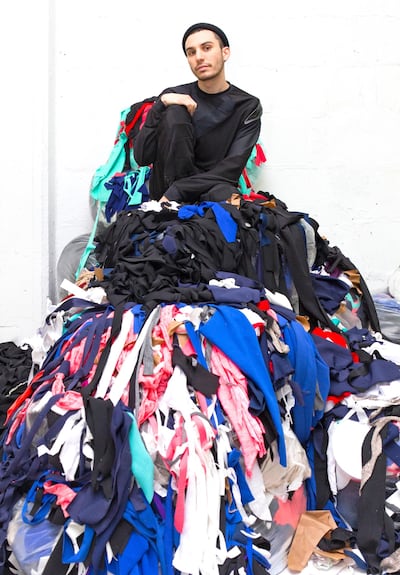Manufacturing clothing is a very wasteful process. On average, 15 per cent of materials are wasted through production. That is 15 per cent of waste at every stage, from fibre to finished garment. Wasted fibre, mistakes and errors at the weaving and knitting stage, damaged dye lots, print tests and textile overages – this all constitutes pre-consumer waste, so-called because the waste is discarded during production, long before it gets to the consumer.
This is hidden waste that most people don’t even know exists, and there’s a lot of it. The process of making clothing is called detractive manufacturing, that is, the pieces needed to make the garment are cut out, and the leftovers are detracted and discarded. That makes for a very wasteful practice. Of the 400 billion metres of textiles produced each year, around 60bn metres of it ends up on the factory floor.
Textiles sent to landfills constitute a particular problem. Polyester and other synthetic materials do not decompose in a scalable timeline, while wool emits methane, which is a major contributor to global warming. Ninety-five per cent of all textiles are recyclable in some way, yet somewhere between 50 per cent and 75 per cent of them end up in a landfill anyway, according to Greenpeace International.
There are as many solutions to textile waste as there are types of waste, each with their own special challenges, and each with examples of designers and brands that have surmounted those challenges. Zero-waste fashion design poses the challenge of eliminating waste by design. It is the process of creating garments where material waste is designed out right from the beginning. That means the pattern pieces have to fit together like a jigsaw puzzle, with no gaps in-between. It is a challenging process for a designer who has to create without compromising fit or aesthetics, while generating zero textile waste.
Here are just a few of the designers working with the concept of producing zero textile waste through their designs. Timo Rissanen, an educator and researcher at Parsons, the New School in New York, and New Zealand academic Holly McQuillan are two of the most prominent proponents of zero-waste design. In their book, Zero Waste Fashion Design, they document their own process of using pattern- making to eliminate waste, as well as that of others, such as Julian Roberts, who invented a pattern-making technique called Subtraction Cutting. Rissanen and McQuillan developed highly complex interlocking systems of designing patterns from a single block of material, while Roberts developed a process that designs around the negative spaces, resulting in unexpected holes and shapes for the body to pass through.
Chilean brand Zurita produces a collection based on indigenous hand-weaving from the region, where pieces are designed and woven to shape. The collection was developed as a response to fast fashion. The weaving is done in the tradition of the native Aymara, who have a long history of backstrap weaving. Made from alpaca fibre, designs respect the indigenous tradition of not cutting textiles, as a result of which, the collection is based on rectangles and squares.
Zero Waste Daniel is a New York brand that creates clothing from other designers’ textile waste, with founder Daniel Silverstein using scraps of fabric that would otherwise end up in a landfill. The collection is comprised of a patchwork of diverse materials, colours and patterns, refashioned into casual leisurewear.
Tonle' is a Cambodian brand that produces contemporary, fashion-forward clothing from small scraps of fabric. Their collections feature piecework and colourblocking. The brand's entire aesthetic is based around the creative problem-solving required to design from other people's leftover scraps.
Shanghai Tang produced a seven- piece capsule collection in collaboration with the EcoChic design award. The winner of the 2015 upcycling fashion contest, Kevin Germanier, was challenged to design a capsule collection using surplus luxury materials from Shanghai Tang’s previous year’s collection. The results were sold online and in-store.
Orsola de Castro, one of the first designers to work with pre-consumer waste says: “In an industry that is increasingly overproducing, very little is being done to highlight how much is discarded at source, and yet what is being thrown away is often intact, still beautiful, and still usable if thought of in a different way.”
Designing with waste is a major area of potential future design development, with large-scale manufacturers repurposing their own waste, through designer collaborations, and recontextualising waste as resource. Imagine H&M partnering with a luxury designer to create an exclusive collection from its leftover fabrics, promoted and sold with all the hype that exists around its "limited-edition" designer collaborations. The expression "one man's trash is another man's treasure" couldn't be truer than in this context.
Sass Brown is a fashion designer, researcher, writer and educator. Prior to joining the Dubai Institute of Design and Innovation (DIDI) as founding dean, Brown was the interim dean for the Fashion Institute of Technology (FIT) School of Art and Design in New York. She is the author of two books on sustainable fashion: Eco Fashion and Refashioned.


